Sailing and watches have long been a natural fit. In addition to a target market of largely well-heeled participants who can afford to accessorize their yachts with luxury timepieces, there is the obvious timing element of regattas that lends itself to colorful chronographs. Many watch brands that have sponsored yacht racing in years past have faithfully trotted out nautical-inspired timepieces. It was only three years ago that the final showdown for the Cup between Oracle Team USA and Emirates Team New Zealand pitted two heavyweight watch brands against each other: TAG Heuer, then Oracle’s timing partner, and Omega, which continued its long relationship with the Kiwis. But after Oracle took home the Auld Mug trophy, TAG Heuer changed its corporate strategy, refocusing on auto racing and the New York Marathon instead of sailing, leaving Larry Ellison’s Oracle team with naked wrists.
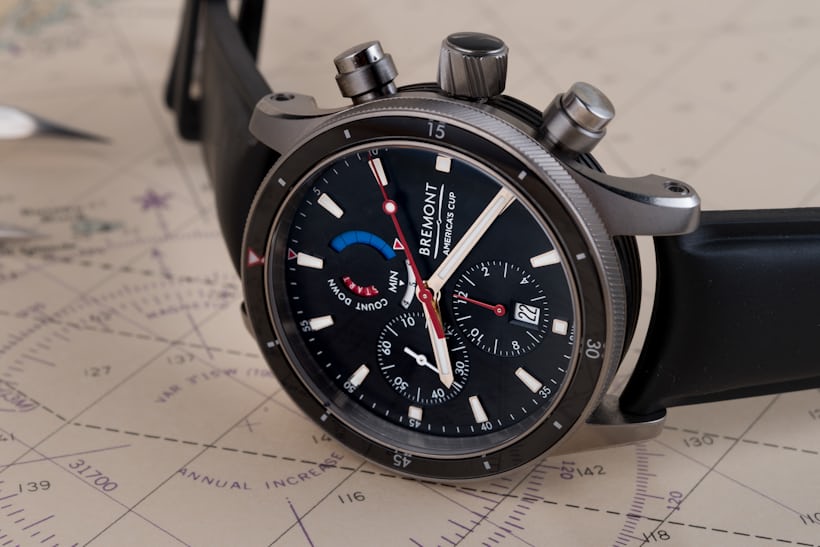
With the ink barely dry on the America’s Cup and Oracle Team USA partnership agreement, Bremont quickly set out to design some special edition timepieces. While the first round of special editions, shown last year, were nice, sporty dive watch derivatives, this year’s Baselworld brought out the more special hardware. I was in Bermuda last fall for the kickoff race series that will ultimately determine the challenger to the Cup next year and I asked Nick English if a proper regatta timer was in the works. In uncharacteristic forthrightness for a watch brand executive, he admitted that, yes, Bremont would unveil it at Baselworld. I assumed it would be based on the Supermarine dive watch, like the Oracle I and Oracle II special editions, but was surprised to see otherwise.
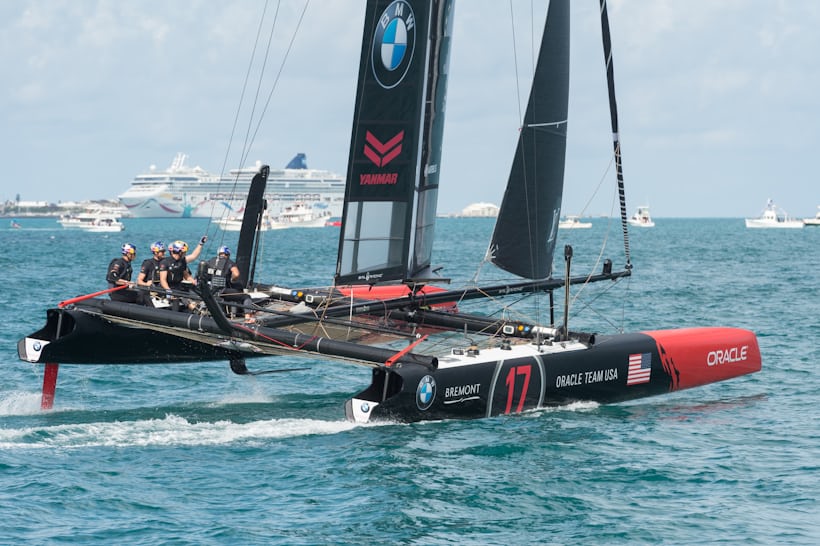
The fleet of Oracle Team USA (OTUSA) regatta watches are the brainchild of Nick English’s brother and fellow Bremont co-founder, Giles, who studied as a naval architect and has a professed fondness for the regatta complication. Regatta timing wristwatches came into their own, like so many other niche tool watches, in the early 1960s. Aquastar was first on the scene, with other brands like Lemania, Heuer, Memosail and many others following in the subsequent decades. The enduring appeal of regatta timers both defies, and is due to, their very specific design and function. Before I dive into the particulars of the Bremont Regatta OTUSA, perhaps a brief explanation of the complication itself is in order.
The function of a regatta watch is elegantly simple: count down to the start time of a yacht race. Sailboats aren't able to wait, stationary, at the start line (an imaginary line drawn between two buoys) so they maneuver close by, waiting for the cannon shot that signals that the race has started, so they can cross the line. As boats gather in the starting area, race officials announce (via bullhorn, blasts from an air horn, or by radio) the start of the countdown clock, in five-minute intervals. Updates are announced until, at five minutes to go, every minute is announced, and finally the last 10 seconds are counted down. This pre-race countdown is a chaotic scene, with sailboats tacking and jibing into position in the crowded waters behind the starting buoys. Having a countdown on his wrist is a huge help for a skipper jockeying for position. Crossing the line too soon results in a penalty or disqualification, but starting too late can mean almost certain defeat, especially in the short, high speed sprints of the America’s Cup races.

In reality, any chronograph can be used as a regatta watch. In simpler versions, the first 15 minutes of the minute totalizer will be colored red to highlight the critical time period. A skipper merely needs to start the chronograph to synchronize it with the race official’s announcement. But some watch companies have modified a chronograph movement to make the countdown timer even more visible and intuitive, using colored discs or an aperture on the dial to indicate the alternating five minute periods of the countdown. As the minutes pass, the indicator will change color until, if it was synchronized correctly, it will be a solid color (usually red) just as the cannon sounds.
The Bremont Regatta OTUSA watches feature two countdown apertures on the dial, as well as a 15-minute “count-up” window and a 12-hour totalizer. The complication is driven off an ETA 7750 base caliber, heavily modified by La Joux-Perret to Bremont’s specification, and is a COSC-certified chronometer; the movement is designated caliber BE-17AE. The countdown function is, of course, what makes it special. The countdown discs at 12 o'clock are activated when the chronograph is started, with the right side disc clicking over half a position every 30 seconds, counting down the prominently marked 5-4-3-2-1, as the window turns from red to blue. Meanwhile, in the left aperture, the word “START” is slowly revealed, fully visible at five minutes, white on red. The 15-minute counter below continues to cycle through its intervals – useful if you started the timer at the 15-minute mark announced by race officials. The 12-hour totalizer at 6 o'clock, with the date nicely integrated, adds time like a conventional chronograph.
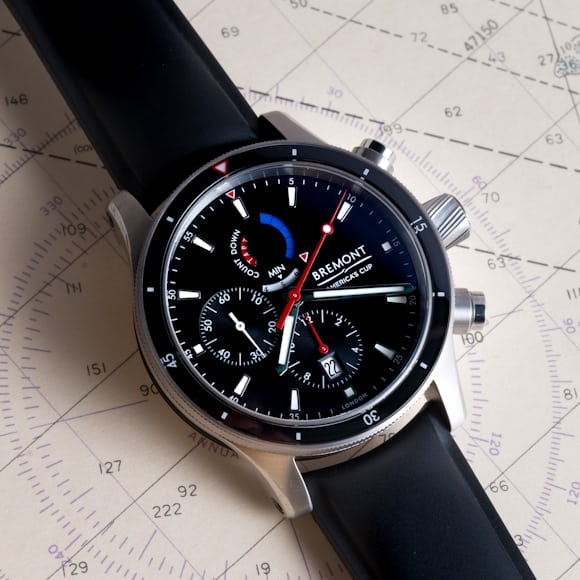
The Bremont Regatta OTUSA comes in two styles – white and black, both identical other than their colorways, with a 43 mm titanium case and thin bi-directional rotating bezel. The white version has a while dial and a white bezel and feels a bit more “nautical” and perhaps more legible, setting off the red and blue countdown discs. I had the black version for a week – enough time to form some opinions.
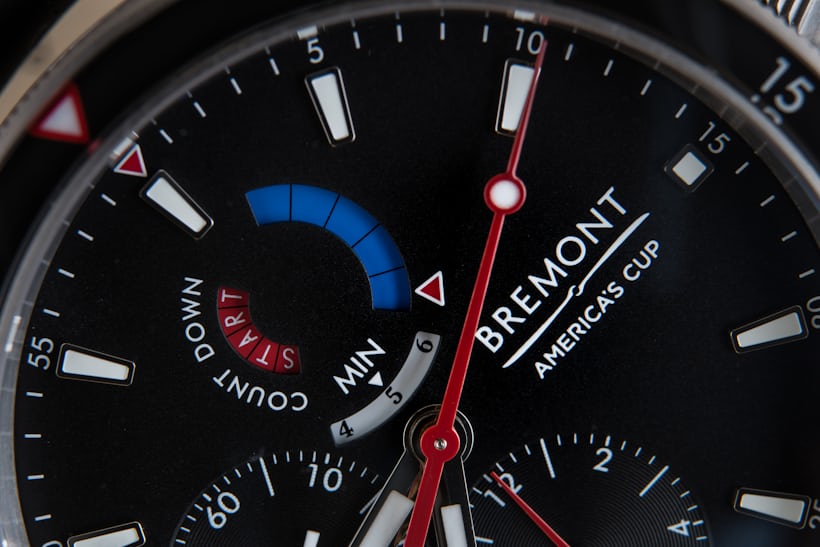
Upfront I will say that, when I first saw this watch at Baselworld, I made no secret that it was one of my favorite pieces of the entire show. This stems from my own love of regatta watches, and a fondness of the Bremont design aesthetic. The case is derived from the Boeing edition watches Bremont makes, with the familiar three-part construction (bezel/lugs, middle barrel, and case back), a radially textured bezel and pusher sleeves, and similar movement finishing. It is a dynamic, sporty watch that looks both rugged and refined at the same time and the addition of the blue and red regatta feature takes that aesthetic even further.
As big sport watches go, it’s comfortable to wear as well. At 43 mm, it’s at the outside of what many consider a good size, but the curved-down lugs and lightweight titanium mitigate any size penalties unless you simply have a smaller wrist. It comes mounted on Bremont’s pliable “Temple Island” rubber strap, which is soft and plenty long but since it lacks any sort of venting, I found it a bit sweaty while wearing it on warmer days.
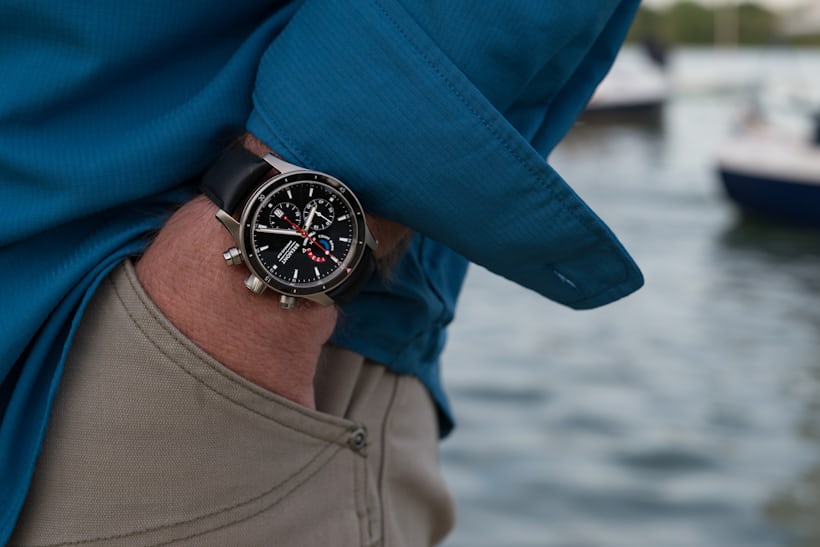
Functionally, all moving parts respond with a crisp ease, which is good because this is a watch that demands a lot of interaction. The bi-directional bezel sits tall and the knurling is very grippy (I’d love to see this style on a dive watch). Its action is fairly loose but stays put when set. I did find the numbers a bit too small for instant read-off by my aging eyes. The radial knurling continues on the oversized crown, which is easy to operate, and the screw-locks for the chronograph push-pieces. A few spins and the pushers are unlocked, ready for use and their resistance is far less stiff than most 7750-derived chronos I’ve tried. In addition, the crown contains a bit of a subtle “Easter egg” – a disc of carbon fiber from the wing foil of the America’s Cup-winning Oracle boat from 2013 is embedded in the crown. It's hardly distinguishable from a standard black crown, but it's a small piece of sailing history nonetheless.
For a watch with so much going on, the dial remains remarkably uncluttered. White pencil hands and markers and some subtle red accents are legible and moving the date to the 6 o'clock position leaves room for the prominent Bremont logo and America’s Cup branding on the right side. One weakness of this dial design is the readability of the countdown displays themselves. Tightly positioned at 12, they are obstructed if either the hour or minute hand is anywhere between 11 and 1, and the 15-minute aperture is very close to the center of the dial, meaning it is also difficult to see. Broader, partially skeletonized hands might have solved some of these issues.

Around back, the sapphire glass gives view to the nicely decorated movement, which has circular graining on the bridges, blued screws, and a subtle wave-pattered rotor signed with “America’s Cup” engraved in red. Bremont prides itself on building rugged watches and this is no exception. The blue elastomer shock absorbing movement holders are visible around the perimeter – technology inherited from the MB and Supermarine series, and carried over from the Boeing pieces. The Oracle team has been routinely spotted wearing last year’s Bremont Oracle watches during races and while I don’t expect team skipper Jimmy Spithill will be relying solely on the regatta countdown feature to time starts in Bermuda next year, I wouldn’t be surprised to see him wearing one of these new chronographs. It’s a testament to the confidence Bremont has in its watches that the team all wear their watches during actual regattas. America’s Cup racing is not genteel weekend buoy rounding and there is huge potential for a watch to get bashed on a winch handle, snagged on rigging – not to mention soaked in salty spray.
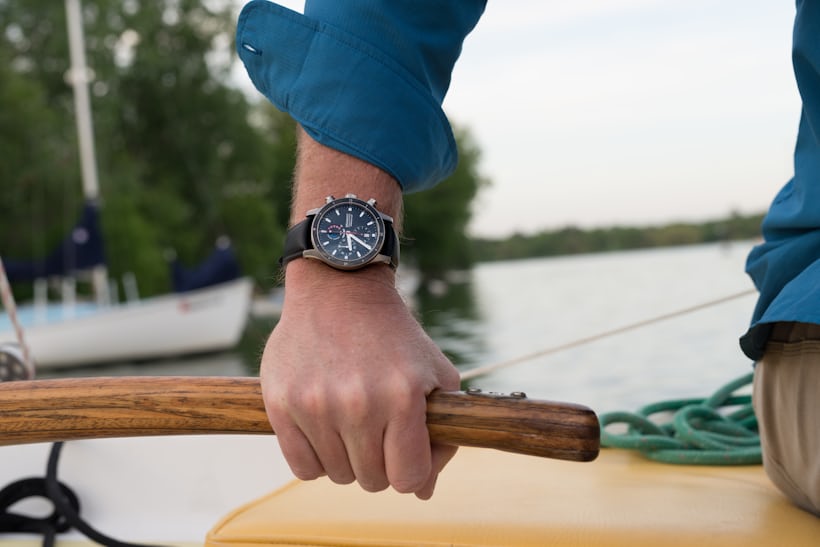
While a regatta chronograph may seem to have a narrow target market, it can have countless other uses for landlubbers as well, timing pretty much anything that can be broken into 5-minute intervals. Plus, it’s arguably more fun to play with than a standard chronograph, due to its interplay of colors and text. Regatta timers are actually one of the few mechanical watches that can be as applicable for their intended use today as they were back in the 1960s. Dive watches and tachymeter-equipped chronos have become largely obsolete to all but the most ardent Luddites, but a mechanical 5-minute countdown is still as useful as a digital one.
With only a handful of brands still offering proper regatta watches these days – Alpina and TAG Heuer come to mind – the Bremont OTUSA is an appealing option for anyone in love with this arcane complication. The watches are limited editions – 235 black, 235 white – and priced at $6,895. More information is available from Bremont here.
All photos by Gishani Ratnayake for HODINKEE.
Jason Heaton is a diver, spelunker, mountaineer, and outdoorsman specializing in the more practical side of horology. A long-time contributor to HODINKEE, he also writes regularly for Gear Patrol as well as other watch news sources and sites. He's also the co-creator of the popular watch and watch lifestyle podcast "The Grey Nato."
No comments:
Post a Comment